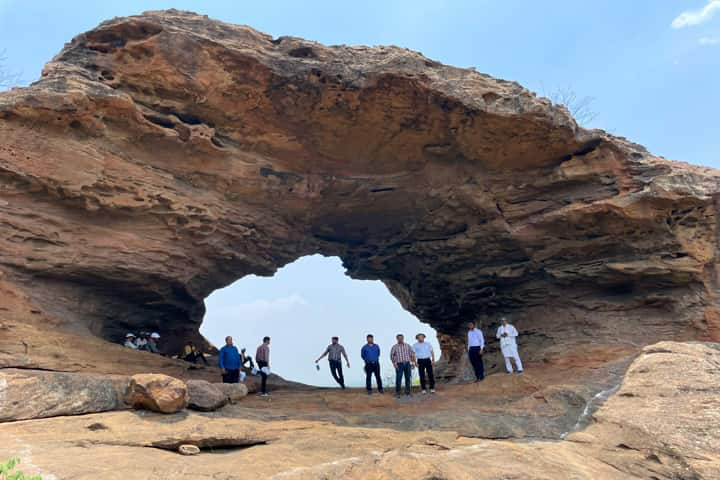Description

Disclaimer: Copyright infringement not intended.
Context: The discovery of a natural arch formation during coal exploration in the Kenduadihi block of Sundargarh district in Odisha.
Details
- Geological Survey of India (GSI) team discovers a natural arch formation during coal exploration in Kenduadihi block, Sundargarh district, Odisha.
- The formation is deemed scientifically and academically significant, with aesthetic value.Recommendation to preserve the site as a national geo-heritage site.
Geological Details:
- Age: Formation dates back to about 184 to 160 million years in the lower to middle Jurassic age.
- Description: The natural arch has a maximum length of 30 meters at the base and a maximum height of 12 meters. It is oval-shaped with an alcove measuring 7 meters in height and 15 meters in width.
- Location: Situated within the dense Chhengapahar Reserve Forest near Brahmani village, surrounded by cliffs and steep sloped hills.
Cultural and Mythological Significance:
- Local Legend: The hill is named Chhengapahar or Chhenga Hill after the natural arch, as "Chhenga" means "hole" in the local language.
- Mythological Connection: According to legend, Lord Rama's arrow shot during his hunt for the golden deer created a hole in the rock, which is believed to be the arch, and landed on the other side of the hill.
Geological Composition and Formation:
- Rocks: The hill consists of coarse to gritty sized, flesh red-colored, poorly sorted, immature, ferruginous sandstone of the Kamthi Formation of the Upper Gondwana Group.
- Structural Triggers: The arch is a structurally triggered-weather eroded natural formation, created by fault systems and associated joints.
- Weathering Process: Subaerial weathering, including rainwater percolation and temperature fluctuations, contributed to the formation of the arch.
Comparison and Significance:
- Two smaller natural arches are found in Tirumala hills, Tirupati, and the Andaman and Nicobar Islands.
- The presence of this natural arch adds to the natural history of Odisha and enhances its importance.
Potential for Tourism and Conservation:
- The arch is expected to attract national and international tourists.
- The geo-heritage tag will encourage geo-tourism activities, benefiting local communities and their livelihoods.
- The arch is safeguarded under the Indian Forest Act, 1927, as it is located in Chhengapahad Reserved Forest. Responsible tourism and awareness campaigns will be implemented to conserve the site.
.jpeg)
Geological Heritage Sites in India
- Geological heritage sites are locations in India that hold significant geological importance and contribute to the understanding of Earth's history.
- These sites showcase various geological processes, rock formations, fossils, and landforms, providing insights into the country's geological heritage.
Importance of Geological Heritage Sites:
- Geological heritage sites offer valuable information about the Earth's past, including tectonic activity, evolution of landscapes, and climatic changes.
- These sites serve as outdoor classrooms, enabling students and researchers to study geological phenomena firsthand.
- Preserving geological heritage sites helps protect unique geological features and ensure their availability for future generations.
Geological Heritage Sites in India:
a) Lonar Crater Lake, Maharashtra:
- Lonar Crater Lake is a unique impact crater formed by a meteorite strike around 52,000 years ago.
- The lake and its surrounding area offer insights into impact cratering processes and subsequent geological transformations.
b) Bhimbetka Rock Shelters, Madhya Pradesh:
- Bhimbetka Rock Shelters are a UNESCO World Heritage Site known for their rock paintings, dating back to the Paleolithic era.
- The site provides evidence of early human settlements and offers insights into prehistoric cultural and geological aspects.
c) Western Ghats:
- The Western Ghats mountain range is recognized as a UNESCO World Heritage Site and is geologically significant.
- It showcases diverse rock formations, ancient granitic terrains, and unique biodiversity hotspots.
d) Barren Island, Andaman and Nicobar Islands:
- Barren Island is the only active volcano in India, located in the Andaman Sea.
- The site offers opportunities to study volcanic activity, lava flows, and associated geological processes.
e) Great Rann of Kutch, Gujarat:
- The Great Rann of Kutch is a salt marsh in Gujarat and is one of the largest salt deserts in the world.
- It provides insights into sedimentary processes, salt formation, and the dynamic nature of coastal environments.
f) Indian Rock Art Sites:
- Various rock art sites across India, such as Edakkal Caves in Kerala and Rock Shelters of Bhimbetka, contain ancient rock paintings.
- These paintings depict human activities, animals, and natural landscapes, reflecting the cultural and geological history of the region.
Conservation and Promotion:
- Geological heritage sites require conservation measures to protect their geological features and prevent degradation.
- Creating awareness among local communities, tourists, and policymakers about the significance of these sites is crucial.
- Promoting responsible tourism at geological heritage sites can generate economic opportunities while ensuring their long-term preservation.
|
PRACTICE QUESTION
Q) Consider the following geological heritage sites in India with their locations-
- Erramatti Dibbalu - Kurnool
- Akal wood Fossil park - Madhya Pradesh
- Shiwalik Fossil park - Himachal Pradesh
How many of the above pairs are correctly matched:
- Only one
- Only Two
- All
- None
Answer: 1 (Only one)
|

https://www.indianarrative.com/science-news/indias-biggest-natural-arch-formed-184-million-years-ago-discovered-in-odisha-by-gsi-145445.html











